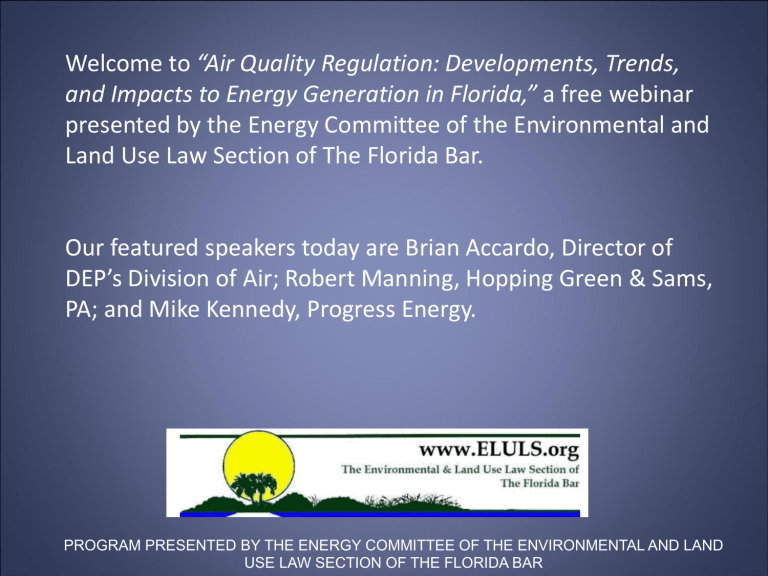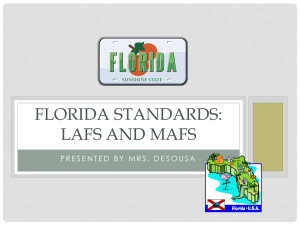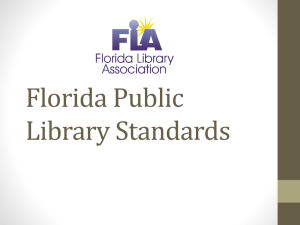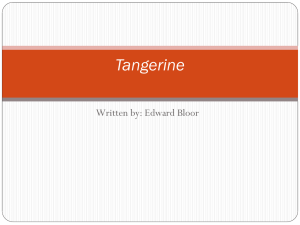Developments,Trends, and Impacts to Energy Generation in Florida

Welcome to “Air Quality Regulation: Developments, Trends,
and Impacts to Energy Generation in Florida,” a free webinar presented by the Energy Committee of the Environmental and
Land Use Law Section of The Florida Bar.
Our featured speakers today are Brian Accardo, Director of
DEP’s Division of Air; Robert Manning, Hopping Green & Sams,
PA; and Mike Kennedy, Progress Energy.
PROGRAM PRESENTED BY THE ENERGY COMMITTEE OF THE ENVIRONMENTAL AND LAND
USE LAW SECTION OF THE FLORIDA BAR
Brian J. Accardo
Director, Florida DEP’s Division of Air
2600 Blair Stone Road, MS 5000
Tallahassee, Florida 32399-2400
Phone: 850.717.9000
E-mail: brian.accardo@dep.state.fl.us
Brian is the director of the Florida Department of Environmental Protection’s
Division of Air Resource Management. In this role, he leads the State of Florida’s efforts to responsibly manage its air resource. In addition to developing and implementing statewide regulatory policy, he oversees the monitoring of ambient air quality, permitting and compliance of emission sources, and siting and licensing of power-generation and transmission facilities.
Robert A. Manning
Hopping Green & Sams
119 S. Monroe Street, Ste. 300
Tallahassee, Florida 32301
Phone: 850.222.7500
E-Mail: robertm@hgslaw.com
A native Floridian, Robert Manning has been practicing environmental law with
Hopping Green & Sams since 1984. Robert’s practice focuses primarily on air quality-related issues, including policy development, legislation, rulemaking, permitting and enforcement. Robert is past Chair of the Florida Bar’s
Environmental and Land Use law Section and the Florida Section of the Air and
Waste Management Association.
Mike Kennedy
Manager of Environmental Affairs
Progress Energy Florida
P.O Box 14042
PEF 163
St. Petersburg, FL. 33733
Phone: 727.820.5567
E-Mail: Mike.Kennedy@pgnmail.com
Mike has 34 years of experience in environmental regulations, permitting, modeling, and compliance. This includes 12 years in air quality planning, permitting, and regulation development with the Indianapolis Air Pollution
Control Division and 22 years in permitting, compliance, strategic planning and environmental policy with the electric utility industry. He currently works as
Progress Energy Florida’s corporate environmental policy liaison with State agencies such as the DEP, water management districts, and the Public Service
Commission.
Air Quality Regulation:
Developments, Trends, and Impacts to
Energy Generation in Florida
Brian Accardo, Director
Division of Air Resource Management
ELULS Webinar
February 27, 2013
Presentation Outline
• Florida Air Program Update
• Ambient Air Quality Standards
• Cross-State Air Pollution
• Regional Haze
6
Division of Air Resource Management
7
Florida Air Program Successes
• Florida’s air quality monitoring network covers 90% of
Florida’s population.
• NO x emissions from power plants have decreased 80% since 2000; SO
2 emissions have decreased 75%.
• Time to process air permit applications has decreased
42% since 2010.
• Florida reducing emissions fees by 10%.
8
National Ambient Air Quality Standards
9
National Ambient Air Quality Standards
• Carbon Monoxide
• Final Rule, 76 Fed. Reg. 54,294 (Aug. 31, 2011)
• Lead
• Final Rule, 73 Fed. Reg. 66964 (Nov. 12, 2008)
• Nonattainment SIP submitted to EPA (June 2012, Feb. 2013)
• Nitrogen Dioxide
• Am. Petroleum Group v. EPA , No. 10-1079 (D.C. Cir.)(July 17, 2012)
10
NAAQS - Ozone
• Ozone
• Final Rule, 73 Fed. Reg. 16,436 (Mar. 27, 2008)
• Proposed Rule, 75 Fed. Reg. 2,938 (Jan. 19, 2010)
• EPA Withdraws
Draft Final Rule,
September 22, 2011
• EPA Proposed
Standard Expected in 2013, Final in
2014
11
NAAQS - Ozone
12
NAAQS – Particulate Matter
• Particulate Matter
• Final Rule, 78 Fed. Reg.
3,086 (Jan. 15, 2013)
• Annual PM
2.5 standard strengthened from 15 to 12 ug/m 3
13
NAAQS – Particulate Matter
14
NAAQS – Sulfur Dioxide
• Sulfur Dioxide
• Final Rule,
75 Fed. Reg. 35,520 (June 22, 2010)
• Florida Nonattainment Recommendations,
June and Nov. 2011
• EPA “120-day” Letters Concurring with Recommendations,
Feb. 2013
• EPA Formal Designations,
June 2013
• Submit nonattainment SIP,
Dec. 2014
• Attain Standard by June 2018
15
Cross-State Pollution – CAIR
• Clean Air Interstate Rule
• Final Rule, 70 Fed. Reg.
25,162 (May 12, 2005)
• North Carolina v. EPA , 531
F.3d 896 (D.C. Cir. 2008), modified on rehearing, North
Carolina v. EPA , 550 F.3d 1176
(D.C. Cir. 2008)
16
Cross-State Pollution – CSAPR
• Cross-State Air Pollution Rule
• Proposed Rule, 75 Fed. Reg. 45,210 (Aug. 2, 2010)
• Final Rule, 76 Fed. Reg. 48,208 (Aug. 8, 2011)
• EME Homer City Generation v. EPA , No. 11-1302 (D.C. Cir.)
• Order granting Motion to Stay, December 30, 2011
• Vacated, Aug. 21, 2012
• Petition for Rehearing Denied, Jan. 24, 2013
17
Regional Haze – CAIR era
• Regional Haze Rule
• 64 Fed. Reg. 35,714 (July 1, 1999)
Develop plans to attain “natural visibility conditions” in national parks and wilderness areas by 2064
Require Best Available Retrofit Technology (BART)
• CAIR is “better-than-BART”
• 70 Fed. Reg. 39,104 (July 6, 2005)
• Regional Haze State Implementation Plan (SIP)
• August 2010
18
Regional Haze – CSAPR era
• CSAPR “replaces” CAIR,
Oct. 2011
• Proposed Limited Disapproval of SIP,
77 Fed. Reg. 4,735 (Jan. 31, 2012)
• CSAPR is “better-than-BART”,
77 Fed. Reg. 33,642 (June 7, 2012)
• Florida’s Regional Haze SIP Revision,
Sept. 17, 2012
• EPA Proposed Full Approval,
77 Fed. Reg. 73,369 (Dec. 10, 2012)
• Final Action Due July 2013
19
20
Air Quality Regulation:
Developments, Trends, and
Impacts to Energy Generation
In Florida
ELULS Webinar
12:00p – 1:30p
February 27, 2013
Hopping Green & Sams
21
Hopping Green & Sams
119 S. Monroe Street
Tallahassee, FL 32301
(850) 222-7500 robertm@hgslaw.com
22
Cooperative Federalism Trends
◦
CSAPR
◦
Other Examples
Sue-and-Settle Strategy
◦
GHG Regulation
◦
Excess Emissions
23
EPA sets standards and states determine how best to implement
◦
State Implementation Plans (SIPs) are cornerstone
24
Cross-State Air Pollution Rule (CSAPR)
◦
Addresses interstate transport in eastern US
Florida included based on modeled impact on
Houston
◦
Final Rule published on August 8, 2011, to take effect on January 1, 2012
25
DC Circuit issued Stay on December
30, 2011
◦
Vacated rule on August 21, 2012
Court held that EPA cannot set standard and issue FIP at same time
26
Other Examples
◦
PSD for GHGs
◦
Regional Haze
◦
Excess Emissions
◦
Enforcement
27
EPA sued for failure to act
EPA enters a Settlement Agreement establishing the substance and schedule for rulemaking
28
◦ Deadlines for EPA’s promulgation often extended, but EPA often uses Settlement to not extend public comment periods
◦
Intervention by affected industry can have standing issues
29
GHG Regulation
Initial Petition to regulate car’s GHG emissions
In 2003, EPA declined and DC Circuit upheld
In 2007, Supreme Court declared GHG a pollutant under CAA, and directed EPA to make an “endangerment finding”
In 2009, EPA did, and its new car rules triggered other CAA permitting requirements for stationary sources
30
GHG Regulation
Recent petitions for EPA to develop New
Source Performance Standards (NSPS) and a
National Ambient Air Quality Standard for CO
2
EPA proposed NSPS for utilities on April 13,
2012
31
Excess emissions during
Startup, Shutdown and Malfunction (SSM)
Sierra Club petitioned EPA to find that SSM rules in 39 states are inconsistent with the
CAA and EPA guidance
32
On February 22, 2013, EPA proposed a
SIP Call for 36 (of 39) states
◦ Many of these state rules (including Florida’s) were approved by EPA over 30 years ago
◦
Also key example of federalism trend, because
EPA is mandating how states must limit emissions
33
34
New Federal Air Quality
Regulations:
Implications for the Electric Utility
Industry
Mike Kennedy
Florida Environmental Affairs
February 27, 2013
Mike Kennedy
Manager of Environmental Affairs
Progress Energy Florida
Mike has 34 years of experience in environmental regulations, permitting, modeling, and compliance. This includes
12 years in air quality planning, permitting, and regulation development with the Indianapolis Air Pollution Control
Division and 22 years in permitting, compliance, strategic planning and environmental policy with the electric utility industry. He currently works as
Progress Energy Florida’s corporate environmental policy liaison with State agencies such as the DEP, water management districts, and the Public
Service Commission.
36
Progress/Duke Energy
July 2, 2012 Merger
Largest U.S. Electric Utility
50,000 MW Generating Capacity (FL:
10,000 MW)
7.1 million Customers (FL: 1.6 million)
104,000 sq. miles Service Area (FL:
20,000 sq. miles)
Diverse mix of coal, oil, natural gas, nuclear, and hydro generating assets
Progress Energy Florida name change to Duke Energy Florida in April 2013
37
Agenda – Impacts We Will Discuss
• Mercury and Air Toxics Standards (MATS)
• Regional Haze
• National Ambient Air Quality Standards
(NAAQS)
• Greenhouse Gas (GHG) New Source Performance
Standards (NSPS)
• Excess Emissions Regulation
• CSAPR Decision
38
MATS Rule
• Stringent new emissions standards for mercury, acid gases (measured as HCl), and non-mercury metals from coal- and oil-fired electric utility units.
• Compliance required by April 16, 2015, with the potential for 1-year extensions to install control equipment and/or to address reliability issues.
• Generally requires flue gas desulfurization
(scrubber) and selective catalytic reduction
(SCR) to comply (coal-fired units).
39
MATS Rule (cont’d)
• The combination of availability and low price of natural gas with the high cost of installing controls results in the tendency to retire coal-fired utility units.
• Example: Units 1 and 2 at Progress Energy’s Crystal River plant.
▫ 900 MW of total capacity
▫ $1 to $1.5 billion to install controls
▫ Currently plan to retire in 2015 to 2018 time frame – MATS rule is a major driver
• Overall result of MATS in combination with other rules will be a much greater dependency on a single fuel – natural gas. By narrowing the choices for electricity generation technology and fuel, the EPA is determining national energy policy.
40
Regional Haze
• Requires installation of Best Available Retrofit
Technology (BART) on certain units. Other units affecting visibility may also need reductions.
• Mainly serves as a backstop to the MATS requirements for most affected units.
▫ For Progress Energy, the BART permit requires the installation of SO
2 and NOx controls on Crystal River
Units 1 and 2 by 2018.
▫ Alternatively, the company may cease operation as coal-fired units by 2021.
▫ MATS compliance requires similar controls by no later than April 2016.
41
NAAQS
• Two small areas proposed for nonattainment of SO
2 standard (portions of Hillsborough and Nassau
Counties).
▫ Remainder of the state will continue to be evaluated using monitoring and/or modeling analysis.
▫ Additional controls or fuel switches may be required if additional nonattainment areas are identified.
• Revised ozone standard likely in 2014
▫ A tighter standard would result in additional required NOx reductions from several major sectors of the economy – utilities, transportation, manufacturing – with proportionate effects on consumer costs.
42
GHG NSPS
• Proposed standard corresponds to the emissions from a new natural gas combined-cycle combustion turbine.
▫ Typical coal unit emits ~ 2,000 lb/MWh
▫ Super-critical coal unit emits ~ 1,800 lb/MWh
▫ Simple-cycle combustion turbine emits ~ 1,200 – 1,500 lb/MWh
• The proposed limit would eliminate new coal-fired units, unless they can incorporate yet-to-be-demonstrated carbon capture and storage (CCS) technology.
• The EPA’s 30 -year average option is not viable. It assumes that CCS will be available in 10 years.
▫ CCS is not demonstrated at utility scale – significant technical, legal, property rights, and liability issues must be resolved.
▫ Utility planners are very unlikely to risk that CCS will be commercially-available (and cost-effective) in 10 years.
43
GHG NSPS
• EPA represents that “Because this standard is in line with current industry investment patterns, this proposed standard is not expected to have notable costs and is not projected to impact electricity prices or reliability.”
▫ The agency is not taking into account that this proposal would further drive the industry toward placing most of its eggs in the natural gas basket.
• In setting the standard, EPA determined that NGCC is the Best System of Emission Reduction (BSER)
▫ NGCC is not an emission reduction system; it is an electricity generation technology
• The NSPS program is not technology-forcing; standards are to be based on commercially-available technologies.
44
GHG NSPS – Potential cost
• Large potential cost for abandoning coal as a fuel for new power plants and relying too heavily on natural gas.
▫ Depends greatly on the supply and cost of natural gas, which historically have been volatile.
• CCS likely to remain technically challenging and costly for many years.
▫ Pilot projects show a 30% energy penalty
▫ Many areas are unsuitable geologically
• Eventually, NSPS will apply to modified and reconstructed units as well as existing units. The existing unit standard may determine whether the current coal-fired fleet can remain viable.
45
Excess Emissions SIP Call
• Current Florida provisions recognize operational limitations of controlling emissions during startup, shutdown, and malfunction periods.
• More stringent federally-driven criteria would result in the need to install additional control systems, and/or would result in a number of new emissions limit violations.
▫ Risk of additional cost from enforcement penalties.
▫ Risk of third-party lawsuits.
▫ Little benefit to environment; Florida currently complies with air quality standards in almost all areas.
46
CSAPR Decision
• Court vacatur leaves the Clean Air Interstate
Rule (CAIR) in effect.
• Florida’s utilities have been complying with
CAIR since 2009.
• Decision maintains status quo, so no additional compliance cost or impact to customers.
47
48









